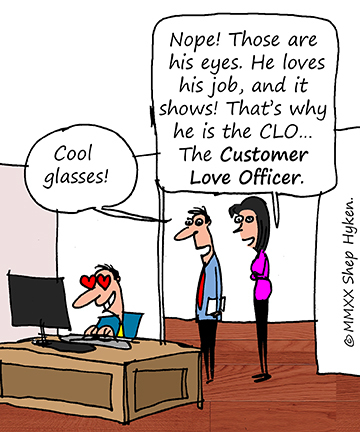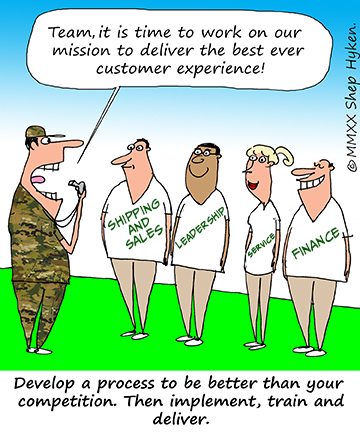Shep Hyken's Blog, page 96
November 1, 2020
5 Top Customer Service Articles For the Week of November 2, 2020
Each week I read a number of customer service and customer experience articles from various resources. Here are my top five picks from last week. I have added my comment about each article and would like to hear what you think too.
If Customer Service Reps Were Honest [Spooky Edition]: The Scary Reality Your Customer Service Agents Face Every Day Plus How You Can Help by Veronica Krieg
(Sharpen) If your customer service reps were honest, here’s a look into what they’d say – and tips you can use to help them during this spooky season and beyond.
My Comment: Just after Halloween, this is the perfect article. It is the scary reality of what happens when you don’t properly manage your customer service reps – and how to right what is wrong. Poor training and abusive customers – both very scary when mismanaged – are just two of the five topics covered in this short article.
8 ways to be a great customer during COVID by Monique Richardson
(Ceoworld Magazine) During this ever changing and challenging time, the ability to be a great customer and extend kindness to those we come into contact within a service environment is more important than ever.
My Comment: Lately, I’m asked about how customer service has changed during the pandemic. There have been changes and the introduction of new tactics and strategies. Who would have thought that we’d ever have to be overtly transparent about our health and safety guidelines? What used to be assumed can no longer be taken for granted. But how about customers? What should they change? So, let’s flip things around and ask ourselves, “As customers, what could we do to be better a better customer?” Here are eight ways!
5 Customer Experience Strategies That Will Make Your Business Conversion Friendly by Dhaval Sarvaiya
(CustomerThink) This is the era of customer experience. A Walker study (opt-in required) found that by the end of 2020, customer experience will overtake price and product as the key brand differentiator. And we all know the role that customer experience plays in current and future conversions.
My Comment: I really liked this article. There are some solid ideas, some we may have thought about before, but they are coming at us from a different angle. All five are relevant to almost any type of business, but pay extra attention to number three, which is about self-service and number four, which is predictive personalization.
The Unique Challenge of Building Customer Loyalty in an Online Only World by Phil Britt
(CMSWire) Marketers and company executives offered the four recommendations to help build loyalty in a digital world.
My Comment: As much of our business is moving to online, digital or automated processes, even though we’re creating a good experience for our customers, at the same time we are distancing ourselves from them. You can’t automate your relationship with a customer. However, there are some ways of building a sense of loyalty, even with little or no human contact, that are worth the effort. While the article doesn’t go deep into the subject, it’s what you need to start the conversation with your team.
13 Customer Service Tips You Should Practice by business.com editorial staff
(business.com) If you follow these customer service tips and teach them to your employees, you can ensure your customers experience the care and attention they deserve from your team.
My Comment: Here is a list of 13 customer service basics. You may have read about these in other articles. You may have been trained on many of them. Well, consider this a refresher. If I were tasked with sharing some customer service tips at my next team meeting, this would be the article I need to get started.
BONUS
Customer Support Through The Eyes of Consumers in 2020 by Hiver
(Hiver) Discover the latest trends about customer support – from how consumers expect more empathy and faster responses during the pandemic to how they react to sub-par customer support.
My Comment: The only reason this is a BONUS is that you have to opt-in with your email address to get the report. First, there are some interesting stats and facts, including how customer service expectations have changed in the COVID-19 era. Second, there are some great comments from other customer service and CX experts that will give you something to think about.
 Shep Hyken is a customer service expert, professional speaker and New York Times bestselling business author. For information on The Customer Focus
Shep Hyken is a customer service expert, professional speaker and New York Times bestselling business author. For information on The Customer Focus customer service training programs go to www.TheCustomerFocus.com. Follow on Twitter: @Hyken
customer service training programs go to www.TheCustomerFocus.com. Follow on Twitter: @Hyken
The post 5 Top Customer Service Articles For the Week of November 2, 2020 appeared first on Shep Hyken.
October 30, 2020
Guest Post: How Voice Technology Can Improve Customer Service
This week we feature an article from Esther Lowde, a Marketing Executive at telbee. She writes about how businesses can utilize modern voice technology to create a better experience overall for their customers.
What is the best way to improve relationships with your customers? The answer is simple but often overlooked: Focus on delivering five-star customer service.
The good news is that in 2020, there is a huge range of tools at your disposal to help you advance your business’ customer support strategy.
As new technologies evolve and adapt, modern businesses are finding new opportunities to have engaging, empathetic and efficient conversations with their customers.
Today, we’ll be discussing how you can make use of modern voice technology and voice AI to drive consistently positive experiences for your buyers.
#1 Voice Technology Helps Keep Things Personal
The importance of empathy in good customer service really cannot be overstated. To avoid becoming frustrated, customers need to feel that they can talk to your business in a way that feels natural, easy, and right for them. And according to Acquia, 85% of marketers say that “a human touch is needed, in addition to technology, for a positive customer experience.”
One of the best ways to put this ‘human touch’ back into your customer communications is to give buyers the option to quite literally ‘speak’ to you – whether that be through scheduling a phone conversation in advance with the right member of your team, or sending you a voice note directly via your website.
So many of the subtleties of tone, nuance and understanding get lost when we write our thoughts down. But voice has been humans’ most powerful relationship-building tool for hundreds of thousands of years!
And while patience, empathy and relatability are important across all of your business’ support channels, there is something about listening to your customers’ voice – and using your own to respond – that helps you connect with your customers on a far more human level. Speaking person to person with your customers will ultimately leave you with more happy buyers who feel as if they’ve been treated like unique individuals, rather than ticket numbers.
#2 Voice Technology Improves Accessibility
Diversifying your support channels is also a great way to ensure that your support team is easily reachable by all of your customer base. Remember that there is no one-size-fits-all approach when it comes to good customer support, and different support channels will work best for everyone.
For example, for customers with hearing difficulties, providing support over email and live chat is by far the easiest and most effective option.
However, when it comes to helping customers who struggle with typing (due to a physical condition such as arthritis or Parkinson’s) or who suffer from severe vision impairment, voice-first support platforms are a far more effective solution.
Allowing these customers to send you a voice note – rather than an email – detailing their problem is a great way of showing them how much you care. It’s also a great way to ensure that you abide by the guidelines set out in the recently updated ADA (Americans with Disabilities Act), which sees inaccessible websites as a form of discrimination against people with disabilities.
#3 Voice Technology Saves Time For You and Your Customers
As we touched on earlier, voice technology can do wonders when it comes to taking a more personal approach to your customers’ problems. However, enjoying these benefits definitely doesn’t mean you have to sacrifice the speed, ease, and convenience of live chat, chatbots, and instant messaging.
In fact, one of the key benefits of voice technology is that it can save both you and your customers huge chunks of precious time. For example, new developments in voice technology and AI have now made it easy for customers’ to schedule a call back from the right person in your team (conversational scheduling) – or even to leave a voice message for you directly via your website.
Both of these approaches cut out the time that your patients might have otherwise spent waiting in line to speak to one of your agents or waiting on hold while being put through to the right person for the job. This boost in efficiency is important as according to Forrester, two-thirds of customers say that the most important aspect of good customer service is that their time is valued.
As well as saving time for your customers, these voice-first methods help you to make better use of your time as a business, as the right person from your team can simply respond personally to your customers when they are ready with answers – and whenever is convenient for them.
The Final Slice
Ultimately, modern voice technology – from conversational scheduling and voice bots to asynchronous voice messaging for business – can help you solve your customers’ issues quickly, easily and conveniently while also allowing you to empathize and connect with them as people. At the heart of it all, isn’t that what good customer service is all about?
If you’re looking for a way to save time on your customer support processes while simultaneously increasing customer satisfaction, consider how voice technology could help. It’s time to start letting your customers decide how they want to be heard!
Esther Lowde is a Marketing Executive at telbee; the voice recording and messaging platform for business. A lover of writing, traveling and digital marketing, she is excited about helping businesses around the world improve their relationships with their customers through the power of voice.
F
 or more articles from Shep Hyken and his guest contributors go to customerserviceblog.com.
or more articles from Shep Hyken and his guest contributors go to customerserviceblog.com.
Read Shep’s latest Forbes article: Your Customers Don’t Want a Sales Pitch–They Want Solutions
The post Guest Post: How Voice Technology Can Improve Customer Service appeared first on Shep Hyken.
October 28, 2020
The New Executive Position: CLO (Customer Love Officer)
 The word love is not used that often in the corporate or business world.
The word love is not used that often in the corporate or business world.
It may have been Tim Sanders in his revolutionary book, Love Is the Killer App, who helped bring the word love to the forefront for leaders trying to build a stronger culture and create a better experience for their customers. People were scared to use the L-word in business. Some still are. Some people say it’s “too soft,” but my take is that it just makes you real. If you truly love your people, love your customers and love what you do, it shows. It’s obvious. Love becomes part of the culture.
My buddy and professional gifting genius, John Ruhlin, talks about “loving on your customers.” It’s his expression for sending customers meaningful and memorable gifts.
I had a great call with a team of real estate agents the other day and we talked about how to show their clients how much they loved them. They were getting ready to promote someone to a position that managed the love process. They asked me if there was a title for that position. I thought about it and here’s what I came up with. This position will be known as the…
CLO, as in Chief Love Officer
If a company can have a CEO, a CFO, a COO, a CXO, why not a CLO? Welcome the newest title to the C-Suite! It turns out that I’m not the first person to come up with this. TV Personality, Steve Harvey, has given himself the title of CLO. A few others—albeit a very few—have also adopted the title.
What does a Chief Love Officer do? For the real estate company, we came up with some of the immediate responsibilities. I’m sure there will be more, and different companies in different industries will have different responsibilities. That said, here’s what we came up with in our first brainstorming session: The CLO…
…is in charge of expressing gratitude to customers.
…is in charge of appreciative follow-ups, such as thank you cards.
…is in charge of remembering birthdays, anniversaries and other important customer dates.
…is the person who makes sure others in the company express gratitude toward customers (and employees).
…in charge of the holiday card list—and other appropriate holiday celebrations, such as Valentine’s Day, where true love can happen.
…works with HR to ensure the people hired fit in with the “love culture.”
If you have been following my work, you know I love fun titles to describe the responsibilities we have in our businesses. My assistant is the Director of Details. We have a social media and marketing person whose title is Director of Reputation. I’m the Chief Amazement Officer. So, “Chief Love Officer” is not that farfetched. Even if you don’t want to assign someone this title, you can still operationalize love in your organization. So, love on your customers—and your employees!
Shep Hyken is a customer service expert, keynote speaker, and New York Times bestselling business author. For information, contact 314-692-2200 or www.hyken.com. For information on The Customer Focus customer service training programs, go to www.thecustomerfocus.com. Follow on Twitter: @Hyken
customer service training programs, go to www.thecustomerfocus.com. Follow on Twitter: @Hyken
(Copyright © MMXX, Shep Hyken)
The post The New Executive Position: CLO (Customer Love Officer) appeared first on Shep Hyken.
October 27, 2020
Amazing Business Radio: Matthew Barnett

Automate the Process, Never the Relationship
The Secret to Building Amazing Company Culture
Shep Hyken interviews Matthew Barnett, the CEO and “Papa Bear” of Bonjoro. They discuss strategies for delighting your customers by delivering amazing service.








Top Takeaways:
Prioritize your company culture above anything else. When customers purchase from you, they’re really buying into your culture.
The first thing you do should be to define your company’s culture and values. Do this early on with intention instead of waiting for it to happen accidentally in the future. Be specific about what your values are.
Assemble a team of your colleagues and employees and work together to define and refine your company’s culture. The people you hire affect the culture you build—for better and worse.
Any time you communicate with your customers, make sure you do so in alignment with your values.
Find the customers that align with your culture and values. Don’t be afraid to “fire” customers if they aren’t a good fit.
Creating an amazing customer service experience really comes down to the idea of delight. Any company can delight their customers.
Build a process where you work delight into various points along the customer journey. The first step is to map out your customer journey and then recognize those opportunities.
It can be difficult to work in delight into an online business—but the opportunity is HUGE. Again, it’s all about mapping the journey (which can be easier online) and putting a process in place.
Creating processes for amazement will eventually become part of your company’s culture. Employees will love it and customers will become “superfans.” This helps you build a great reputation.
Automate the processes you build, but never your relationships. Never sacrifice the human element.
Quotes:
“It all comes down to the idea of delight. It’s an underutilized word. Have a process for working surprise and delight into every single customer journey.”
“Customer service should be your growth team. These are the people who turn your customers into superfans who then go and tell all their friends about you. Whether you’re B2B or B2C, it doesn’t matter. Your service center is your growth team.”
“Automate processes, never relationships.”
About:
Matthew Barnett is the CEO and “Papa Bear” of Bonjoro. Originally trained as a designer and artist, Matthew is committed to building both great products and great culture. His goal is to be the next Zappos—the most loved brand in the world.
Shep Hyken is a customer service and experience expert, New York Times bestselling author, award-winning keynote speaker, and your host of Amazing Business Radio.
The post Amazing Business Radio: Matthew Barnett appeared first on Shep Hyken.
October 26, 2020
5 Top Customer Service Articles For the Week of October 26, 2020
Each week I read a number of customer service and customer experience articles from various resources. Here are my top five picks from last week. I have added my comment about each article and would like to hear what you think too.
Predictions 2021: B2B Marketers Build Digital Pathways To Distanced Businesses by Lori Wizdo
(Forrester) As B2B marketing leaders wrap up 2020 with a keen eye on customer satisfaction and revenue acceleration, they must start looking forward to make sure they are planning for the right strategic pivots and preparing to adopt and optimize new tactics.
My Comment: You don’t need to look into a crystal ball to know what is going to happen next year in the world of marketing and CX. Just look at this group of predictions from Forrester. For those solely focused on customer service and experience, pay attention to the comments about AI, chatbots and virtual assistants.
The Future Of Business Is Customer-centric: 3 Pillars To Create A Customer-centric Strategy by Ilenia Vidi
(Ceoworld Magazine) To become truly customer-centric companies should make these 3 pillars the key drivers to creating their customer-focused strategy.
My Comment: This short article focuses on three “pillars” you want to consider when driving a customer-focused organization. It’s like a three-legged stool. You need all three (or more). If you lose one of these legs, the stool falls over. They make sense. Focus on the human experience, the digital experience and the culture. I’d say those are three great places to start.
Brand loyalty is changing due to the pandemic by Chris Morris
(Fortune) COVID-19 has already tested our patience, our focus, and our compassion. Now it could be testing our allegiance as well.
My Comment: Creating brand loyalty is more important than ever. And COVID-19 changed the way customers buy along with their logic in what they buy. Here is a snapshot of how loyalty is changing during the pandemic. Even if you’re not in retail, it’s important to understand basic consumer behavior, as more and more it crosses over into the B2B world.
Wegmans, Trader Joe’s Master Pandemic Customer Service by Gina Acosta
(Progressive Grocer) Trader Joe’s and Wegmans have managed to keep their customer service cred intact this year while other food retailers have seen their service scores wane during the pandemic.
My Comment: I believe every company should look outside of their industry to get a full understanding of the opportunities they have to deliver an amazing customer service experience. Two grocery retailers, Wegmans and Trader Joe’s have done a stellar job of mastering customer service and experience during the pandemic. There’s plenty of other retailers (beyond grocery) that have kept their ratings high. Here’s an article filled with the stats from the ACSI (American Customer Satisfaction Index) that will give you some ratings. If you see a company on the list you want to learn more about, just Google away.
Customer service: Tips to make your buyers feel VIP by Gerardo Rodríguez
(Entrepreneur) “How they make you feel” is the most important factor in deciding whether or not a person will buy from a certain company again.
My Comment: Here is a simple concept. Make every customer feel like a VIP (Very Important Person). Here you’ll find a few reminders – although for some of you this will be new – about how to make your customers feel like you care about them – like they are special. Even though you need to get beyond basics, it’s still not rocket science.
BONUS
The State of the Contact Center in 2020 | Industry Report by Ben Ringshall
(Fonolo) Shrinking budgets, growing attrition, and a scramble to deliver safe and secure working environments. The State of the Contact Center in 2020 is a far cry from where we expected it to be this time last year.
My Comment: For those of you in the contact center world, you will definitely want to read Fonolo’s State of the Contact Center industry report. It includes insights from leaders in the customer service world as they comment on budgets, AI, outsourcing and much more. You’ll have to download the report to get it – and it’s worth it.
 Shep Hyken is a customer service expert, professional speaker and New York Times bestselling business author. For information on The Customer Focus
Shep Hyken is a customer service expert, professional speaker and New York Times bestselling business author. For information on The Customer Focus customer service training programs go to www.TheCustomerFocus.com. Follow on Twitter: @Hyken
customer service training programs go to www.TheCustomerFocus.com. Follow on Twitter: @Hyken
The post 5 Top Customer Service Articles For the Week of October 26, 2020 appeared first on Shep Hyken.
October 23, 2020
Guest Post: Transactions Are Dead, But Customers Live On
This week we feature an article from Geoff Webb, the Vice President of Products at PROS. He explains the importance of building a solid, human relationship with your customers in the digital world.
There are no transactions. Not anymore.
Two hundred years ago, buyers purchased all types of items – food, clothing, furniture – from vendors they knew and trusted. Then along came chain stores, the supermarket, and the internet. Suddenly people were buying from companies they never met – strangers! – without giving it a second thought.
But change is inevitable and buying behavior changed once more.
Perversely, the very technology that drove the “impersonalization” of transactions has now brought us full circle. Buyers no longer accept the faceless transaction across the internet. Rather, the process of buying digitally has created a demand for a new kind of relationship between buyer and seller, one predicated on deeper understanding, far greater personalization of offers, and exceptional customer experience. And I do mean ‘exceptional’.
As businesses have adopted digital selling channels, forced by a move away from traditional, face-to-face selling modes, buyers have responded by wanting to take control of the engagement, flexing their own digital muscles to move between vendors, to self-educate, and to demand better service at every step. Without a traditional sales exec to manage the relationship, this leaves many businesses suddenly feeling exposed and unready for a buyer who wants to reach into the very heart of their business.
Instead of a single point of contact, buyers now expect to receive consistent, exceptional service from the entire business, at every stage, regardless of how they are engaging. Want to browse the entire inventory online? It better be there. Want to purchase from an ecommerce portal, change your mind and call a sales exec? It better be seamless. Need someone to help you make a complex purchase decision? Get that expert online, stat! Want to know exactly how to squeeze the utmost value from your purchase today? Where’s that support manager?
It’s time for every part of your business to align and be ready, because no purchase is just a transaction anymore. Every interaction is a step in a dance, a note in a symphony, and if you want the music to go on, your business needs to be playing in perfect harmony. To push the metaphor just a little further, your conductor is the customer and every part of the orchestra better know their part.
The good news is that for those businesses that are able to fully align and show value for customers at every interaction, the rewards will be huge. Each exchange with a customer builds deeper understanding of their needs, and every success (or well-managed failure) builds trust that the next exchange will be even better.
This is a self-reinforcing loop of closer understanding, better service, and deeper commitment from buyers. And most importantly, it’s achievable.
It’s achievable as businesses build data and services that span every part of their business. Sharing insight and understanding so that every part of the business that touches customers has a clear view of what the customer needs – to then be able to add value by listening, learning, and feeding insight back into that common view.
It’s achievable because aligning the pressure to digitally transform with the need to serve customers better can unlock market-disruptive potential in technology that’s available off-the-shelf (or at least off-the-cloud) when coupled with a genuine, top-down desire to deliver the best customer experience.
Most importantly, it’s achievable because businesses are doing it today – building a common data lake of customer engagements and behaviors, applying the analytic power of AI to parse the raw information to identify opportunities for improvement that others may miss. And then delivering that insight across the business, every time, to continually improve every interaction.
The bar is high, and every good interaction that your customers have, every exceptional moment of service, simply sets the bar higher. The key to unlocking entire markets is simply this: make sure you’re the business who is setting the bar for everyone else.
The world of transactions is dead. Long live the world of the customer.
Geoff Webb is the Vice President of Products at PROS, where he works with technology, marketing, and go-to-market teams. He helps customers accelerate and optimize their digital transformation strategy, building business operations around a core of A.I. and machine learning-powered business and revenue optimization solutions.
F
 or more articles from Shep Hyken and his guest contributors go to customerserviceblog.com.
or more articles from Shep Hyken and his guest contributors go to customerserviceblog.com.
Read Shep’s latest Forbes article: The Influence of Gen Z
The post Guest Post: Transactions Are Dead, But Customers Live On appeared first on Shep Hyken.
October 21, 2020
Compare Yourself to the Best
 Stop comparing yourself to the competition.
Stop comparing yourself to the competition.
It’s okay to ask yourself, “What are they doing that we aren’t?” However, that can be a dangerous question. I use the word dangerous to warn you that all you are doing is “baseline thinking.” I call it that because it’s at the base.
Realize that others in your industry are probably asking themselves the same question. If all you do is copy your competitor, then you risk being the same as them—not an organization that’s different, and ideally better. In worst-case scenarios, you become a commodity. It doesn’t matter if you’re B2B or B2C, you become just another version of the same. I encourage you to take it a step further and make it better.
My suggestion is to go beyond the competition and look at the best companies from any and every industry. That said, there are steps that address the competition. This is a real opportunity to improve. To help you do this, I came up with a process to get you from just thinking about how to be better than your competition to actually becoming better.
1. Assemble your team, which includes leadership and several other members from various departments that include front line and behind-the-scenes responsibilities. The key is having a diverse group of thinkers.
2. Even though I want you to think beyond your competition, you should still do the exercises in this step and the next. List your competitors and ask two questions: “What are we doing that they don’t do?” followed by, “What are they doing that we don’t do?” The first question will make you feel good about yourself and your company if, in fact, you do something different. The second question will help you find that “dangerous opportunity.” You must be able to keep up with your competition, and this exercise helps.
3. Make a plan to execute on what’s needed to keep up. If you do copy what someone else is doing, try and find a way to make it your own. Improve on it or give it a twist. Look for differentiation, not duplication.
4. Time for another meeting. Get the same group together for another brainstorming session and start with the question, “What companies, not including competitors, do you like doing business with the most?” Make a list. It doesn’t matter what type of business it is. Popular companies and brands include Amazon, Apple, Nordstrom, Zappos, and others recognized for amazing service and customer experience. The list could include a local restaurant, a shoe-repair, real estate agency, law firm, manufacturer and more. Any company counts.
5. Share why you enjoy doing business with them. Everything counts. The more on this list, the better—even if it seems like common sense.
6. Make a note of everything they do that you already do. Feel good about this. Take a moment to celebrate!
7. Now comes the fun part. Look at that list and determine if there are other things they do that you don’t do. This is the opportunity to find ways to increase the level of service and experience that not only you don’t do, but that your competition doesn’t do either. This is the experience growth opportunity, and it is what will help set you apart from the competition.
Why do business with you? Going through this process will make that question easy to answer. Compare yourself to the best—from any industry—and borrow their best service ideas. Your value proposition is a unique or different process or approach that will help you get new business as well as retain existing business. And who doesn’t want that?
Shep Hyken is a customer service expert, keynote speaker, and New York Times bestselling business author. For information, contact 314-692-2200 or www.hyken.com. For information on The Customer Focus customer service training programs, go to www.thecustomerfocus.com. Follow on Twitter: @Hyken
customer service training programs, go to www.thecustomerfocus.com. Follow on Twitter: @Hyken
(Copyright © MMXX, Shep Hyken)
The post Compare Yourself to the Best appeared first on Shep Hyken.
October 20, 2020
Amazing Business Radio: Lou Gallagher

Focus on the Customer, Not the Sale
Building a Customer Engagement Strategy That Lasts
Shep Hyken interviews Lou Gallagher, Consumer Engagement Specialist at Mitel. They discuss strategies for improving customer service, interaction, engagement and experience.








Top Takeaways:
Become a partner to your customer. Work to solve your customers’ business needs without trying to make a sale.
When selling technology, focus on solutions and success instead of the technology. Identify business problems and needs before turning to technology.
Lose the mindset of customer service happening only in call centers and contact centers. Go broader, and think instead about consumer engagement and consumer interaction.
Technology has progressed rapidly, opening up new channels of communication. Companies must be ready to meet their customers on these new channels and provide a consistent consumer interaction experience.
Ideally, create an omnichannel communication experience. This allows you to communicate with customers across all channels using a single interface on the back end. This creates consistency, helps the agent provide better service and gives the customer a better experience.
Customers and companies alike should ask more open-ended questions when communicating with each other to facilitate a productive conversation. Customers should ask what that company is doing to understand their needs and entire journey.
Companies must ask themselves what their consumer engagement strategy is, whether or not it is holistic (stretching company-wide) and if it is truly customer-centric (instead of product- or sale-oriented).
As technology changes so quickly, be mindful of how you do and don’t adopt it. Don’t get too enamored with new tech and lose sight of the humans behind it—both your customers and employees.
Everyone in an organization has a positive or negative impact on the customer service and experience, not just the customer service department. It’s part of the company’s culture.
Quotes:
“First, we need to understand what the business needs are without talking about product. Lose the religion on product; gain the religion on the company’s success.”
“Ask what your consumer engagement strategy is and how holistic it is. Is it based on a product, technology or group within the organization—or is it based on your consumers? Look at it from your consumers’ point of view.”
“Everybody, in every organization, has positive and/or negative impact on consumer (customer) interaction. Consumer interaction is part of the culture.”
About:
Lou Gallagher is a Consumer Engagement Specialist at Mitel. With over 35 years of experience as a business leader, business consultant, IT application developer and engineer, Lou has created customer engagement strategies that reduce cost and enhance CX.
Shep Hyken is a customer service and experience expert, New York Times bestselling author, award-winning keynote speaker, and your host of Amazing Business Radio.
The post Amazing Business Radio: Lou Gallagher appeared first on Shep Hyken.
October 19, 2020
5 Top Customer Service Articles For the Week of October 19, 2020
Each week I read a number of customer service and customer experience articles from various resources. Here are my top five picks from last week. I have added my comment about each article and would like to hear what you think too.
What Is Voice of the Customer and What Does it Mean for Customer Experience? by Scott Clark
(CMSWire) Voice of Customer (VoC) programs have been shown to improve the customer journey when brands use VoC metrics to obtain actionable insights, but only when those insights are used to make positive changes to a product, service, or business. Yet many leaders do not understand the benefits of a VoC program, what it entails, and how it can be used.
My Comment: VOC, or Voice of the Customer, has been a term that has been misunderstood by many. The gist of it is simple. Listen to the customer and then do something with what you hear. Sure, it’s an oversimplification, so take a few minutes to read this robust article that includes a clear description of VOC, how to use it and the stats or measurements you may consider using.
37 Customer Experience Statistics You Need to Know for 2021 by Toma Kulbytė
(SuperOffice) We recently asked 1,920 business professionals to share their number one priority for the next 5 years.
My Comment: I love good stats and facts, and here is a bunch of them. Some are a bit dated, but the general meaning behind them hasn’t changed. CX is important – more than ever – and every company needs to be motivated to make it a priority. This information should do the job.
How to Reimagine… Revolutionize 2 by John Dijulius
(The Dijulius Group) This incredible lineup of experts shared so many brilliant “Ah-ha’s” it almost brought our chat feed down.
My Comment: My buddy and fellow CX expert, John DiJulius, puts on an amazing customer service and CX conference every year. This year it is virtual and instead of two or three days, is a month of amazing content from amazing speakers. This is the recap of the second week. If you love this, and you should, you will want to go back and look at week one. You may even want to register to have access to the recorded speeches and interviews. For now, check out the summary.
How To Deliver Ace Customer Service While Working Remotely by Team Inc42
(Inc24) As we grapple with the aftermath of an unprecedented attack by an invisible enemy, the world is now forced to embrace this new era of remote working. While this has surely ushered in its share of challenges, it’s really encouraging to see that businesses are adapting to the new normal with commendable zeal.
My Comment: Working remotely (from home) is no longer exclusive to a small percentage of the employed population. It has become the norm for many companies. This is an excellent article with all types of information that will help you and your company deliver a better customer service experience while working remotely.
14 Smart Ways To Leverage User-Generated Content by Expert Panel®
(Forbes Communications Council) These two elements make user-generated content an essential tool a business can leverage to enhance its marketing and outreach efforts. Sadly, most companies don’t fully tap into the potential of this cost-effective, successful way of engaging customers.
My Comment: It is an enviable position to have customers who are willing to talk about you – and even write articles and testimonials about you. And once they do, what’s the best way to use and leverage that content? Here’s an article from the Forbes Communication Council with 14 ways on how to do so.
BONUS
How to Improve CX with Better Chatbots by Matt Wujciak
(CCW Digital) Just as our everyday lives have changed in significant and unprecedented ways, so has the world of customer support. Support teams in all industries are navigating new ways of working and the outbreak’s impact on key metrics like inbound volume, wait times, and CSAT scores.
My Comment: Chatbots are still a hot topic, especially in the customer support world. They have come a long way over the years – and still have a ways to go. Lots of experts, including myself, weighed in on this report. You’ll have to share your email address to get the report, but I believe you’ll be very happy you did once you read it.
 Shep Hyken is a customer service expert, professional speaker and New York Times bestselling business author. For information on The Customer Focus
Shep Hyken is a customer service expert, professional speaker and New York Times bestselling business author. For information on The Customer Focus customer service training programs go to www.TheCustomerFocus.com. Follow on Twitter: @Hyken
customer service training programs go to www.TheCustomerFocus.com. Follow on Twitter: @Hyken
The post 5 Top Customer Service Articles For the Week of October 19, 2020 appeared first on Shep Hyken.
October 16, 2020
Guest Post: Customer Experience – Can It Work With Email Marketing?
This week we feature an article from Alex Souchoroukof, a content writer at Moosend. He shares some digital marketing strategies that can help to create a more meaningful customer experience.
There are a lot of tools in today’s marketing that can help drastically increase your revenue and grow a successful brand. The problem is that most of them don’t focus on the customer experience, which is a vital element to stand out.
Think about this statistic for a moment: Buyers are willing to pay more for excellent customer service. Yeah, I know. I was blown away, too.
A great way to build relationships with your potential customers and accomplish a great experience is by using the old traditional email.
In this article, we will explore how email marketing can help you on this journey.
1. Start With an Excellent Introduction
You have to start from the beginning. Welcome emails are an incredibly underrated kind of communication. Your prospects just subscribed to your email list, so you have their full attention and an opportunity to convert.
Introduce your brand, show your values, and tell them what steps they need to take next. Open rates are higher with welcome emails, so consider that and build a secure connection from day one.
2. Birthday Emails
Sending a birthday email is a simple yet efficient way to increase your traffic to your store and your conversions.
Birthday emails can include special offers, discounts, or even a free gift, to show that you appreciate your customers. It’s an excellent way for your brand to build rapport with them and encourage them to take action.
Birthday emails should have a cheerful design, be personal, and have a clear call to action. This kind of email is a great way to increase revenue as they have 179% higher unique click rates than other promotional emails.
3. Send Customer Satisfaction Surveys
A survey is a great way to understand what your customers want and need and to improve the experience for them in the future. Attracting new customers is quite expensive. To avoid that, make sure that your current customers are happy and are willing to buy from you again.
Add interactive questionnaires to make it more fun and listen to the answers. Great customer experience comes from listening to your audience—their pain points, their fears, and what they love about your brand.
Offering a discount code at the end of the survey can also improve the overall experience, and the users will be more willing to complete the tasks.
4. Random Offers For Your Customers
Email marketing can be a great way to show that you care about your customers. This doesn’t mean that you will approach them only on special occasions. At any time of the year, potential customers will appreciate a special offer.
During quiet periods it can be an effective way to boost your sales and create some traction for your brand. Find ways to make it fun for your subscribers and as engaging as possible to increase the click-through rates.
Scratch cards and Gift Boxes can be useful in this kind of scenario. Apart from that, you can always trust the simple discount offers. It’s up to you and the characteristics of your list.
Conclusion
Email is a powerful tool to attract new potential customers and build solid relationships with them. You can’t hope that they will purchase if you randomly send weekly newsletters. Make sure you upgrade your game with all of the tricks above to have a more engaged audience. Email marketing should be an essential part of every marketing plan to improve the human experience.
Remember that we are talking about customer experience. Creating an experience is quite a complicated story, but offering value and showing your customers that you care about them will do the trick.
If you keep one thing from this article, this should be the following:
“You have to start with the customer experience and then go back to your product or service.”
I always like to hear from you, so let me know in the comment what kind of strategy you will implement first in your next email marketing campaign. I can’t wait to see what other techniques you are using for your emails. Until next time…
Alex Souchoroukof is a content writer at Moosend. Coming from an architecture background, he took the leap of faith in the digital marketing world and never looked back. In his free time, you will find him taking photos in places around the world. Find out more about Alex on his LinkedIn, Facebook and Instagram.
F
 or more articles from Shep Hyken and his guest contributors go to customerserviceblog.com.
or more articles from Shep Hyken and his guest contributors go to customerserviceblog.com.
Read Shep’s latest Forbes article: World-Renowned Chef Daniel Boulud Shares His Recipe For Success Amid COVID-19
The post Guest Post: Customer Experience – Can It Work With Email Marketing? appeared first on Shep Hyken.




